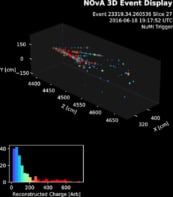Theoretical physicists have discovered an algebraic error in calculations of the magnetic moment of the muon which means that recent measurements of the moment do not disagree with the Standard Model of particle physics by as much as had first been thought. The result reduces the probability that the measurements have revealed evidence for new particles.
In February the Muon (g – 2) experiment at Brookhaven reported a value for the magnetic moment of the muon that disagreed with the Standard Model prediction by 2.6 standard deviations. This meant that there was only a 1% chance that the results were due to a statistical fluke. The g-factor of a particle relates its intrinsic angular momentum or ‘spin’ to its magnetic moment.
Simple quantum theories predict that g=2 for particles such as electrons and muons. However, radiative corrections that cause the continuous emission and re-absorption of short-lived virtual particles means that g is not exactly equal to 2. These radiative corrections can be caused by familiar particles from the Standard Model or by more exotic particles not included in the model. Precise comparisons of the predicted and measured values are therefore a good way to search for new physics beyond the Standard Model.
However, when Marc Knecht and Andreas Nyffeler of the Centre for Theoretical Physics in Marseilles checked the theory, they discovered that three groups had miscalculated a quantity known as the pion pole contribution. All three had found the contribution to be -55.6 x 10-11 when it should have been 55.6 x 10-11.
When the Standard Model calculation is repeated with the correct value, there is a 13% chance that the difference between theory and experiment is due to a fluke. The experimental team is currently analysing additional data from the muon g – 2 experiment, and will announce its results “sometime this winter or early spring”.



